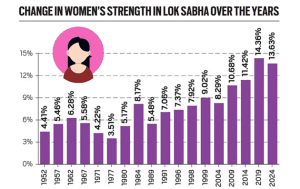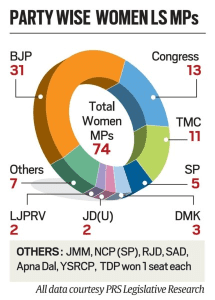TAG: GS 2: SOCIAL JUSTICE AND GOVERNANCE
THE CONTEXT: The 2024 Lok Sabha elections have seen a significant representation of women in the elected body.
EXPLANATION:
Historical Trend
- The representation of women in the Lok Sabha has shown a general trend towards increasing women’s representation over the years.
- However, progress has been slow and not linear.
- In 1952, women made up just 4.41% of the strength of the Lower House.
- This number increased to more than 6% in the election held a decade later, but again dipped to below 4% in 1971.
- Since then, there has been a slow, but steady rise in women’s representation, which crossed the 10% mark in 2009 and peaked in 2019 at 14.36%.

Current Representation
- In the 2024 Lok Sabha elections, 73 women have been elected, making up 13.44% of the elected strength of the Lower House.
- This is a decrease from the 78 women elected in 2019, but still one of the highest proportions since 1952.
- Party-wise Representation
- The representation of women varies across political parties.
- The Bharatiya Janata Party (BJP) leads with 31 women MPs, followed by the Congress (13), Trinamool Congress (11), Samajwadi Party (5), and Dravida Munnetra Kazhagam (3).
- Seven parties have one woman MP each.
- The Trinamool Congress boasts the highest proportion of women MPs at 37.93%, followed by the Congress (13.13%) and the BJP (12.92%).
- New Faces and Age Profile
- Of the 74 women MPs elected, 43 are first-time MPs, and one (Misa Bharti of the Rashtriya Janata Dal) is a first-time Lok Sabha MP.
- This is higher than the overall percentage of newcomers in the House (59% Vs 52%).
- Women MPs have only 0.76 Lok Sabha terms of experience, indicating a relatively new group of representatives.
- The average age of women MPs is 50 years, younger than the overall age of the House at 56 years.

Education and Experience
- Women MPs are as educated as their male counterparts, with 78% completing undergraduate studies.
- They have an average of 0.76 Lok Sabha terms of experience, indicating a relatively new group of representatives.
Candidates’ Composition
- Out of the total 8,360 candidates who stood in the 2024 Lok Sabha elections, just around 10% were women.
- This number has increased over time, standing at 3% in 1957.
- This is the first time that women candidates’ proportion has touched 10%.
- Roughly 16% of BJP’s candidates were women, as opposed to 13% of Congress candidates — both higher than the overall average.
Challenges and Opportunities
- Despite the progress made, women still face significant challenges in entering and staying in politics.
- The Women’s Reservation Bill, which aims to reserve one-third of seats in the Lok Sabha and state legislatures for women, is yet to be implemented.
- The bill’s implementation will depend on a delimitation exercise based on the first Census post-enactment.
Women’s Reservation Act, 2023
- It modifies a single constitutional provision, Article 239AA, and adding three new articles: Articles 330A, 332A, and 334A.
- Article 239AA (Amended)
- Article 239AA to the constitution grants special status to the Union Territory of Delhi as national capital with regards to its administrative and legislative functioning.
- Article 239AA(2)(b) was amended by the Act accordingly to add that the laws framed by parliament shall apply to the National Capital territory of Delhi.
- Articles 330A
- The Act provided that reserved seats for women may be allotted by rotation to different constituencies in states or Union Territories for representation in the Lok Sabha.
- In the seats reserved for SCs/STs, the Act sought to provide one-third of the seats to be reserved for women on rotational basis.
- Articles 332A
- The reservation of seats for women in every state Legislative Assembly.
- Additionally, one-third of the seats reserved for SCs and STs must be allocated for women, and one-third of the total seats filled through direct elections to the Legislative Assemblies shall also be reserved for women (Article 332).
- Articles 334A
- The reservation will be effective after the census conducted after the commencement of this Act.
- Based on the census, delimitation will be undertaken to reserve seats for women.
- The reservation will be provided for a period of 15 years (Sunset Clause).
- However, it shall continue till such date as determined by a law made by Parliament.
- Provisions of this act shall not affect any representation in legislative assemblies and the Lok Sabha until their dissolution.

